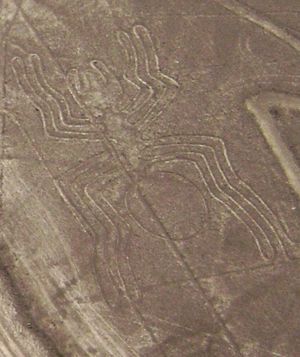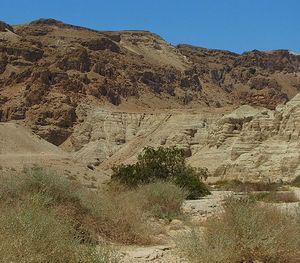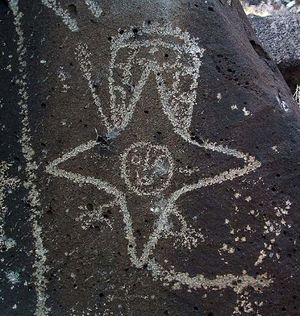The birth of Venus out of Orion (VII)
The spider is an outstanding deity in North American Indian mythology, it is connected to wind/ whirlwind and rain (-water floods). "Maheo appointed Thunder and Whirlwind to be the special guardians of the Sacred Arrow Bundle. They are the protectors of the Cheyennes and their sacred ways. The people believe that if enemies ever attempt to destroy Mahuts, the Arrows, Thunder and Whirlwind would prevent them from doing it." (Powell 1969 Vol 2:438) Cheyenne are not afraid of thunderstorms and tornadoes, for the Blue Sky Maker has the ability to communicate with these powers. He asks them to go by or split. In their dreams, relatives of Edward Red Hat, who has been the Blue Sky Maker for more than 30 years, before he was selected Arrow Keeper, saw him going along with a tornado / whirlwind, spinning his black handkerchief in a twirling motion. Black, as well as red and blue, are the colours of the Tsistsistas Arrow Keepers (Schukies 1993: 29-34, 188-189).
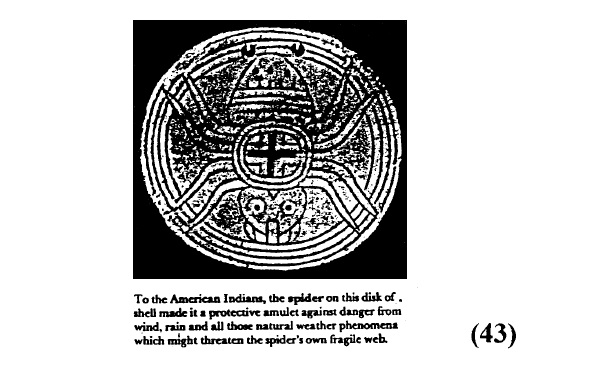
The spider on the shell gorget of the Southern Death Cult of the cultures in the Mississippi Valley and the Southeast is marked by an isosceles Venus-cross, which is encircled by three orbit-lines (Cooper 1978/1984; Martin, Quimby, Collier 1947: 361365). (Fig. 43)
The spider has eight legs and its head resembles the heart. The heart is mistakenly often considered as a symbol of more recent Christian-European tradition; the heart of Jesus. But the heart is an ancient symbol, which was already known in prehistoric Japan or Egypt. A heart forInI tit lithg rail old anthropomorph statue from the neolitic Jōmon culture, which is dated to 2000 BC to the year 0. Two hearts decorate the Sphinx of Giseh on a relief, which shows Thutmose IV (-900). (Droemer/Knaur 1963: 80-85; Rix 1983:13). 0n a bronze heart with Greek inscriptions, the Egyptian Horus / Venus, on a crocodile and on a lotus, is portrayed. A stone formed like a heart, with two holes in the middle, was dug up from ancient Germanic times. Natural stones with holes in the middle were considefed as helpful amulets against lightning in later Germany. (Hansmann 1966:137,180,181) The heart can be considered another symbol of Planet Venus. Its quite outstanding that the American spider is encircled with four lines, on the second orbit, counted from the inner ring towards the center, the two balls reappear, which were already seen on the chest of the Lightning God (cp. Fig. 34).
These two balls, with "eye brows" above, are another Mayan glyph for Venus (Closs:147) There is a long line of pictorial evidence that these two balls turn into the endless number of "two sun"-symbols, or "two eyes"-symbols which are found all over the world. These two suns transform into anthropomorphic figures, like the Lightning Brothers from Australia. (Jelinek 1976: 520, Abb. 845). Of these Lightning Twins one is bigger than the other, which perhaps can be interpreted the following way: The bigger brother is the oldest Lightning Brother, or War Twin, and the smaller one is the younger Lightning Brother, or War Twin. In Tsistsistas history Motseyoef / Venus becomes younger in springtime and older in wintertime, what might be due to its movements as Morning and Evening Star.
The Venus-cross is the heart of a thunderbird, who is painted on a sacred shield of the Sioux (Fig. 44).

It is also the sign of the Germanic goddess Frigga, who is again representing Venus (Fig. 45).

The four-pointed star is the sign for the Morning star with the Tewa Indians in Arizona. In this picture he has eagle claws. Next to the star sits a spiraling snake. (Fig. 46)
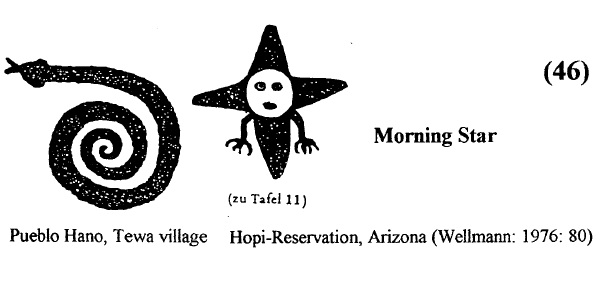
A German stone sculpture from the late 7th Century, representing Christ on the Cross, shows a German Iron Cross / Venus above an hourgalss or sky / Venus sign. The marterial stone lines make up the hourglass, the isos (Isis)-celes(tial) cross / Venus. The immaterial form inbetween these lines again resembles the German - Iron Cross / Maltese cross - Venus. (Fig. 47)
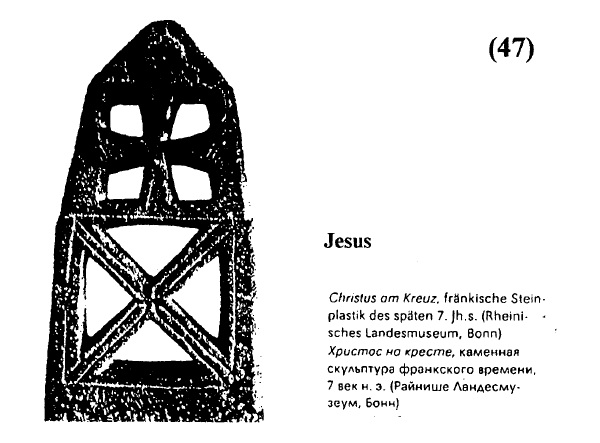
Already Stephen (1940) realized that two hourglasses laid across each other, produce the Maltese cross, which is the sign for Quetzalcoatl, too (in Patterson 1992: 77). (Fig. 48)
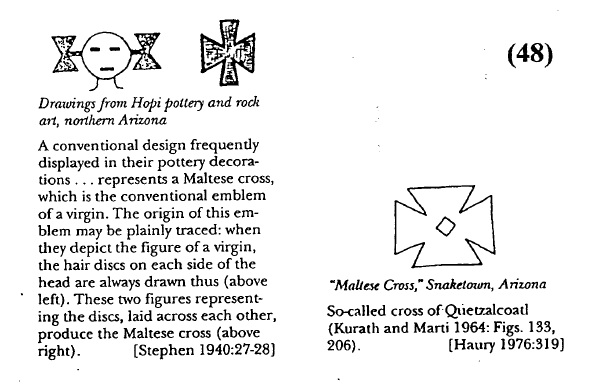
The rhomb in the cross of Quetzalcoatl resembles another Morning Star / Venus symbol of the Cheyenne (Fig. 49)

In the Massaum Ceremony the Cheyenne use the Maltese cross to represent the Morning Star / Venus (Grind 1923/172: 280, 305, 318) (Fig. 50).

The title of a small pamphlet of the American Tract Society reads: "The Morning Star; or stories about the childhood of Jesus, I'm the root and the offspring of David, and the bright and Morning Star" (New York 1855, Rev.22:16). [1] In the Qumran Scrolls, which apparently represent documents of the "primary church", and cannot be separated from the early beginnings of Christianity, a star is of central importance and plays an outstanding role.

Also in the Dead Sea Scrolls the symbol of a star is mentioned over and over again. In Numeri 24,17 it says: "a star rises out of Jacob". Simon Bar Kochba, the leader of the second rebellion against the Romans between 132 and 135 A.D. called himself "son of a star". The fight against the "Kittim" (Romans) is described in methaphysical terms, as the fight between the "sons of the light" against the "sons of the dark". In the Qumran war scroll it is written, that the star will fight successfully, together with the poor or the just, against the invading enemies. In the Damascus Scripts it's said, "the star, that is the explorer of the law ..." The figur of the Messiah appears in the text exclusivly in the picture of a star. These people of the star called themselfes zealots, fanatics for the law. (Baigent, Leigh: 1991: 181, 263)
Motseyoef / Sweet Medicine or Falling Star, brought the law also to the Cheyenne. What we consider their mythology, the Cheyenne consider their law. The core of the teachings. resembles some central Christian commandments, which find parallels in Buddhism, too. The people of the community of Qumran (Fig. P) purified themselves through a "meal of all gathered", which has been compared to the last supper of the primary church. In every traditional Cheyenne meeting, a shared meal is of high importance, with the same purifying charakter. Before eating a blessed drink of water is shared, taken from the same cup. From everything eaten, a piece is given to Maheo first. Also ritual selfpurification through withdrawel into the wilderness finds an equivalent in the vision quest of the American Indian.
In Qumran the people are poor, they share what they have with those that are in need. Motseyoef prophecied to the Cheyenne, "you will always be poor". And that is their general condition today, but they still share the little they have. The Indian Giveaway and Potlach are best examples for this attitude. Motseyoef told the Cheyenne to love another and respect life. This law being at the heart of every religion, it seems, the law of the heart (Lectures of Prof. Harald Wohlrapp, Philosophy Department, University Hamburg, 1980) Prior to his departure from earth Motseyoef / Venus described the qualifications his successor should possess. "Now you must select a good man; one who is good-natured and of good character in every way. These are certainly attributes of the cultural hero Jesus to whom the old Arrow Keeper Red Hat often compared Motseyoef. It was very important to him "to let white people know about this". One argument he used: "also the Cathlics have no women in it".
According to Baigent and Leigh the teachings of Paulus, on which Christianity was later based, were a severe deviation of the original or pure teachings, when "women were still in it". Paulus set God aside and put the worship of Jesus in his place. Jesus becoming the counterpart of Adonis, Tammuz, Allis, Baal, Osiris, or any other of those dieing and resurrected gods, who were so popular in the Near East in those days. To overcome these rivals, Jesus had to perform even greater miracles then they did. And especially in this period of development many of the miracles happened, which Jesus supposedly performed. Basically they are inventions of Paulus which contradict the pure teachings of Jacobus and the communities in Jerusalem and Qumran. (1991: 229-231)
In Babylon Venus was also portrayed as a sixpointed star on the Shield of David, as a fivepointed star, or pentagram, on the Seal of Solomon, sometimes also as an isosceles cross. (Velikovsky 1950/1978: 163) The Gnostics called the fivepointed star, the flaming star. In runic characters the sixpointed star represents the cosmos. As a hexagon it transforms into the, KA-Rune (Rune of Justice), which is attached to Venus, as is the seven. (Kosbab 1982: 43, 215-216) The sign for Venus in Northwest-Mesopotamia is the sevenpointed star, scratched into the sculpture of Nabonid, the last king of Babylon, about 522 BC. The people of Harran, the Sabians, were called star worshippers. (Thames & Hudson, 1963:203) (Fig. 52)
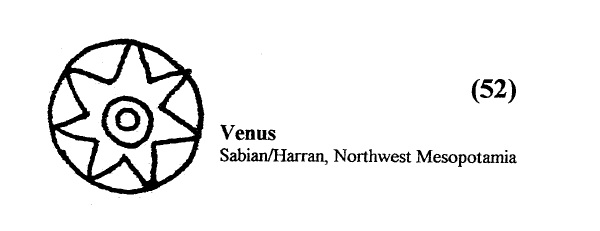
A Chumash cave painting in California, dated to about 900, shows a sevenpointed star with an isosceles Venus cross in the middle. They are both encirceled by a ring of flames. (Wellmann 1976: 74-75) (Fig. 53)
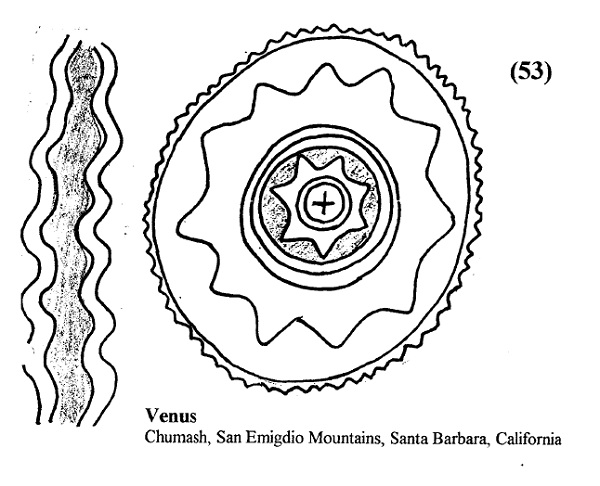
In the Mojave Desert, California, in Chemehuevi Indian territory, "A dramatic discovery was a red radiating symbol with a 'tail', which may represent a comet. — The Kawaiisu, who in culture and language are closely related to the Chemehuevis, also believed in a Sky Coyote, sometimes referred to as 'White Coyote'. It was said that he may be seen going across the sky, and that the sight of him portends death and destruction." (Patterson 1992: 65) (Fig. 54)
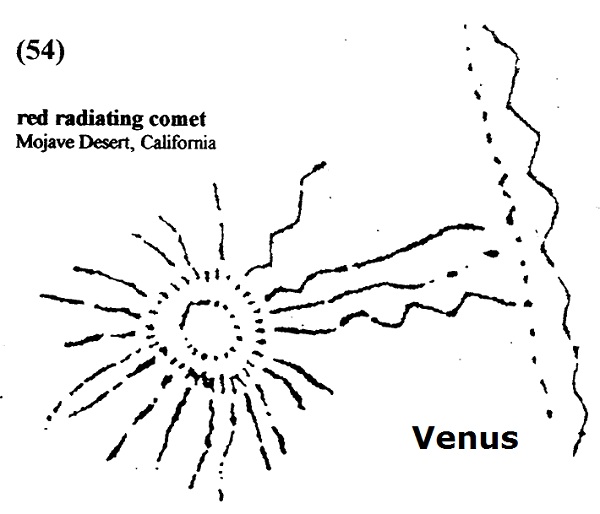
This comet is made up of two circles, from the outer one radiant rays extend. The comet tail is made up of three orbit lines. In a sign from New Mexico (Fig. 55) the outer of the two circles is made up of 23 dots, the upper half counts 13, the half below only 10 dots.

These ten dots relate in meaning certainly to the ten feathers or rays which are decorating the Sky God from figure 2, that whole configuration most likely representing the Lightning God, Venus, again. The second inner circle is marked with the cross of QuetzalcoatI / Venus. According to Schaafsma (1980) [2] this sign might refer to Quetzalcoatl.
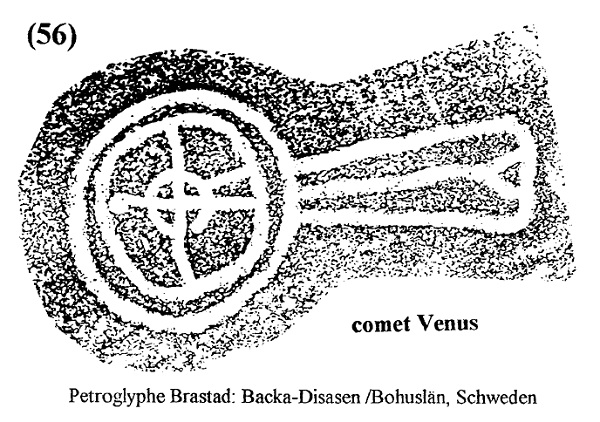
An impressive petroglyph from Sweden shows another variant of this comet Venus. (Fig. 56) The innermost circle is marked by a Venus-cross, also the second inner ring shows a Venus cross. The comet-tail is made up of three lines as well, of which the middle one is marked by two horns at the end of the tail. This detail reminds of the many horned snake motives which are found almost everywhere. On the other end the same line seems to end in a small ball. But this ball might have come as well from the outer line which crosses the middle line in the center of the Venus-cross. In conventional interpretation this extremely complex symbol is interpreted as a phallus. (Evers 1995: 72)
Also the comparisons of other symbol-groups like snakes, dragons, water monsters, or anthropomorphs, they all lead to the same conclusion, the world obviously has only one cultural hero, Venus, the Morning and Evening Star.
The End
Back to:
Appendix
Illustration:
- Fig. 43 - 56: Archive Renate Schukies
- Fig. O: Wikimedia Commons, File:Nazca Lines, Spider.JPG (image processing by Atlantisforschung.de)
- Fig. P: Wikimedia Commons, File:Qumran cave.jpg (image processing by Atlantisforschung.de)
- Fig. Q: Wikimedia Commons, File:Rinconada Star Being.jpg (image processing by Atlantisforschung.de)
Footnotes:
- ↑ Editorial remark: cp. Revelation 22:16 (World English Bible)
- ↑ Editorial remark: see Schaafsma, Polly, "Indian Rock Art of the Southwest", School of American Research, Santa Fe. Albuquerque: University of New Mexico Press, 1980
